#sylaise
Text
Evanuris ??

The characters with beautiful helmets on the vinyl cover of the Dragon Age soundtrack obcess me !! Who are they ?
I also drew Flemeth, Fen’Harel and a character that appears in a trailer (next to the character with a pickaxe helmet)
Nine elven gods.
I have soooo many questions !!!!!
(My assumptions about their identities (from left to right) :
Andruil, Mythal, Dirthamen
Sylaise, Fen’harel, June
Ghilan’nain, Falon’Din, Elgar’nan)
#dragon age#evanuris#dragon age fanart#dragon age theories#mythal#andruil#fen’harel#dirthamen#Sylaise#June#ghilan’nain#Falon’Din#Elgar’nan
279 notes
·
View notes
Photo
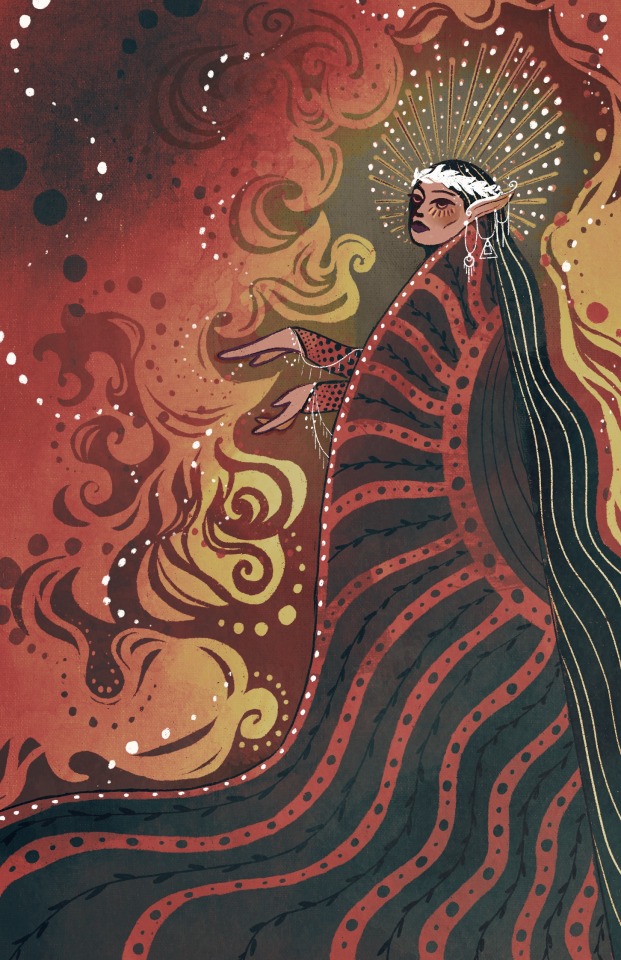

Sylaise and June
#damn I love drawing fire#don't know why it took me so long to get around to drawing these guys#also yes I will be drawing the egg man but I'm working my way up to the heavy hitters so he's last#evanuris#sylaise#june#dragon age#dragon age inquisition#dragon age elves
442 notes
·
View notes
Text
also okay so these are my interpretations of each of the Pantheon's realm
Elgar'nan — Vengeance, protection and righteous anger. Lord over and under the sun, father of Gods, Magnificent among the rest of them. Lord of War, victory and love which knows no bounds. Bearer of loss. His is the light of the sun and the task of protecting the future of the Elvhen, there where no justice can serve.
Mythal — Justice, protection and wisdom. Lady over and under the moon, who comes and rules the sea, mother of Gods, Magnificent among the rest of them and loved by Elgar'nan. Lady of Strategy, public rejoice and stability. Bearer of growth. Hers is the hope in the night and the task of seeing over all civic life.
Dirthamen — Knowledge, Secrets and Piety*, of the unwavering loyalty and quickest of understandings. Heir to the time of Endless Creation which is to come after the War and, therefore, Heir of Mythal and Elgar'nan. Lord of Serenity and quiet but undying passion, his are the mountains and the stars. Undaunted by Fear and Deceit, all lies and betrayals are abhorrent to him. His is the task to record all history.
*Not to be mistaken with solidarity between peoples.
Falon'din — Time and death. The one untouched by Blight, who cannot be tainted by the Void. Scryer of the futures of Elvhenan because only he knows the weight of time involved in their becoming. Shepard of the Dead. Considered the Eldest in merit of the children of Elgar'nan and Mythal, first of the children to bear a realm. He's the only Creator/Evanuris who can actually understand and feel the passing of time. Because of this, he is owed reverence.
Sylaise — Creativity, diplomacy and peace. Lady of Fire and Home, who reminds of the importance of temperance in one's endeavours. She who gave the Elvhen the gift of creating beauty for beauty's sake. Lady of mourning, as she bears all that for war is lost. Hers are the arts, the gift of gab and of medicine, which she rules over with her brother Dirthamen, Heir of the Elvhen. Her is the task of peaceful resolution of disputes.
June — Resourcefulness, material creation, craftsmanship, commerce and mastery over one's actions. Giver of joy and kindness, pillar of peace as there cannot be peace in lacking, protector of quartermasters and workers alike, to whom nothing is impossible. Husband of Sylaise. His is the task of invention, as he bears the weight of curiosity and love which asks for nothing in return.
Andruil — Fortune, chances, sacrifice, births and rot. Lady of the Hunt and of Survival. Master of swiftness and over-looker of Oaths — to swear on her name and not complete the task is to invite bad luck to the oath-breaker. Lady of resolute action, who is predator and prey. Thematically, she is the most opposed to Sylaise.
Ghilan'nain — Dire circumstances, guidance, overcoming obstacles and navigation. Lady of crossroads and pathways, hers are the river-ways and trails. Protector of trailblazers and patroness of the inevitability of choice. Most beloved by Andruil. Bearer of travelling, and therefore, of yearning, distances, but also of discovery.
Fen'Harel — Deception, lies, illusions, missed opportunities and trickery. The compass to what is Not. Teacher of bitter lessons. Lord of Lost Youth, false hopes and exile. Bearer of Guilt and the cost of Pride. He is an omen of danger and is drawn by fear. Thematically, most opposed to Dirthamen.
#dragon age#dragon age meta#dragon age headcanon#dalish hcs#dalish elf#dragon age elves#the evanuris#worldbuilding.exe#elgar'nan#mythal#dirthamen#falon'din#sylaise#june#andruil#solas#fen'harel
135 notes
·
View notes
Text


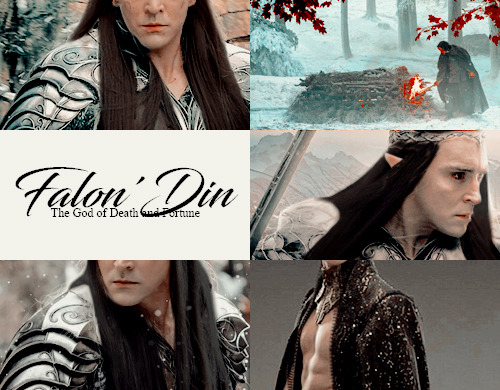
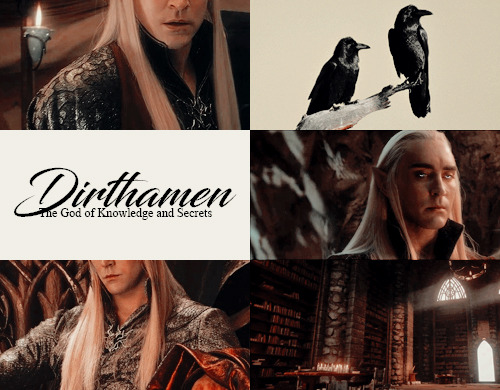

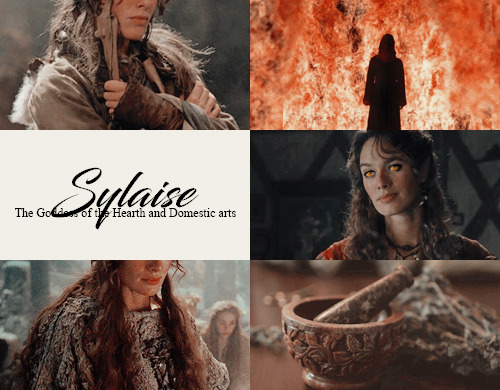

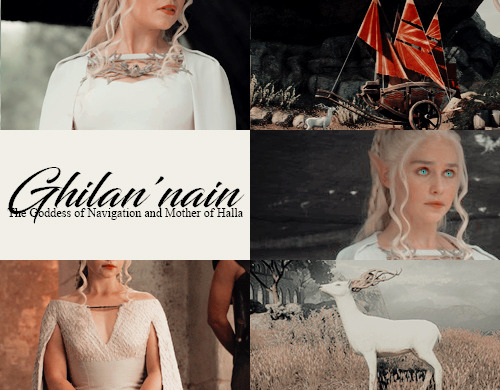

"-And when the Evanuris had finally went to far, I formed the veil and banished them forever."
The Evanuris + Aesthetics
#dragon age#dragonageedit#dai#dragon age: inquisition#dragon age inquisition#the evanuris#fenharel#mythal#ghilannain#june dragon age#sylaise#andruil#dirthamen#falondin#elgarnan#dragon age elves#solas#solas dragon age#solavellan#dragonage#dragonageinquisition#dragonageinquisitionedit
154 notes
·
View notes
Text
Brecilian Ruins - DAO
[Remade post, originally from here]
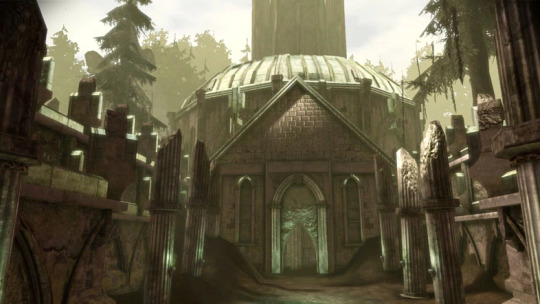
I don't know what to make of Brecilian Ruins. Can we truly trust DAO design with its statues? Spoiler answer: no.
[This is part of the series “Playing DA like an archaeologist”]
The following post contains
Tevinter architecture filled with Elven traps
Iconography
The Well of Sorrows: DAO version
The Tevinter Artefacts
Extra minor details
[Index page of Dragon Age Lore]
Tevinter architecture filled with Elven traps
The first thing we have when entering these Ruins is Morrigan telling us that, despite seeing the whole place with the same architecture we saw in the Ruins of Dalish origin, this is Tevinter. Sure, we can assume that the Dalish hunters know nothing of Elvhenan Architecture or Tevinter Architecture, so their opinion about those ruins being elven could be wrong from the first moment. They are, after all, extremely unreliable beholders of the reality.

Anyways, let's assume Morrigan is right and we see Tevinter arquitecture with Elven traps. This is quite different of what we usually find in Thedas: which is elven structures appropriated by Tevinter humans. This makes sense when you think that the elves were the first creatures in this world, and humans came later, in addition to Tevinter always co-opting any knowledge or techniques from the Elvhenan.
However in Brecilian forest the order of the events seems to be on the other way around. Historically speaking, it can be explained in the following way: we know that Tevinter invaded Ferelden and built many structures with defensive purposes, like Ostagar [which was built to contain the “danger” of the Chasind in the far South].
We also know in the DLC: Witch Hunt, that slaved elves ran away from the North to the South years later after the fall of Arlathan. We know they hid for a while in a Thaig, but maybe some could have reached these forest and inhabit the ancient human structures, protecting themselves with elven traps to keep Tevinter slavers away from them.
Another possibility is that Tevinter simply co-opted the Elven traps and used them in their own buildings. It would not be the first time doing this.
Iconography
The Ruin corridors and chambers are filled with statues. They are the same statues we saw in Zathrian's camp: Sylaise (woman with a vessel), Andruil (woman with a sword. Why? Should not be a bow?), and Ghilan'nain (woman without head and hands).
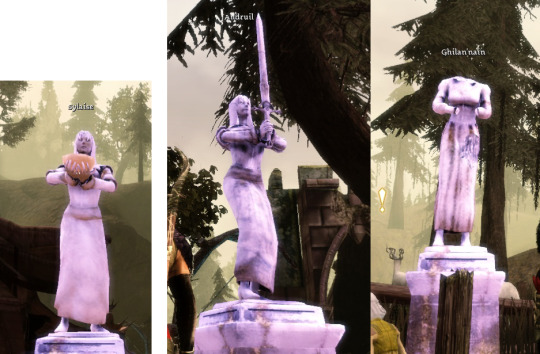
These are the same exact statues we find in any Chantry, Circle of Magi, or human town, so this is exactly why I never trusted DAO design in general. I don't know if the engine and its lack of resources made them reuse a lot of background details, or there is a real intention in them [I incline to the former]. Considering that DAO had almost 10 years of development, I want to believe that this is not by chance... but maybe the limitations of the engine forced them to remove most of the potential that environmental telling has to offer... I don't know.

In any case, inside the Brecilian Ruins we see a symbol or figure we also saw in the Dalish origin: a kind of dragon-head like figure, accompanied many times by one of those figures that we believe, it represents Andruil (the goddess of Hunt). This could also represent Andraste [who always has a sword or a shield in her representations] beside two figures that look like dragon heads. This would link Andraste with Dragons too, which has been a repeated association that we are not stranger to.
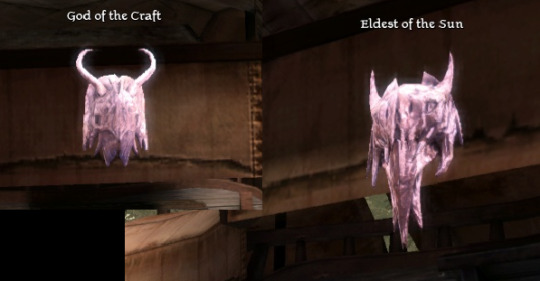
In DAO we see that the dalish are deeply related to Dragons too if we pay attention to the enviromental details that are not repeated anytwhere else: in Zathrian's clan we see many aravels with masks that are dragon-like skulls, and when you click on them, you find out it's a representation of one of their elven pantheon.

We see the concept art of these in the credits of the game.
By now it's quite difficult to say if this is an obvious link of the Elven Pantheon with dragons or maybe Old Gods, or it's just a vestige of former slave elves whose masters may have forced them to worship the Old Gods. It is not strange that a slaved group takes the religious symbols of their slavers and worship them in the name of their own (forbidden) gods. We know that we can't trust in Dalish tales as reliable sources of History, because it's extremely fragmented and lost (thanks to DAI we are truly aware of how false they are containing barely a pinch of truth in them, twisted and romanticed).
On the other hand, I am inclined to think that this is just a representation of how the Elvhenan had, originally, a religion based on Dragons. We know that they venerated a “divine” shape that was meant for their gods and their chosen ones that implied Wings, and due to Mythal’s shape, we associate this Divine Shape with the form of a Dragon. Additional material that can support this speculation can be found in the first three comics of DA comics [The Silent Grove , Those Who Speak, Until We Sleep] where we are informed that the Dragons were the ones who controlled the skies originally, possibly had a broad power over the Fade [Dreamer-like, so from the Fade they could alter reality], and they may have been related to an original non-fragmented “song” that everythign and everyone in the world sang. Also, Dragon Blood is “the blood of the World”, placing the Titans in a confusing position within the lore.

In these Ruins we find a codex of Falon'Din. Which is the same god that Talem told us about when we asked him if he could identify that strange winged statue. So... the confusions gets worse here: it's a Tevinter Ruin, with elven traps, and Elven God statues.
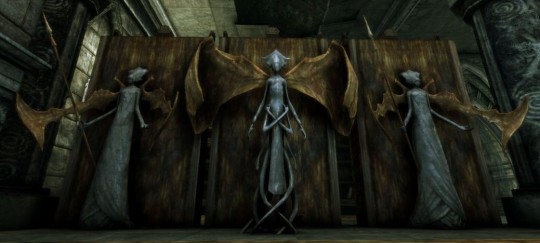
It’s impossible to overlook the fact that this statue of Falon’Din has strong resemblance to the Old God statue of Urthemiel. As if Falon’Din wanted to have the shape of Urthemiel.
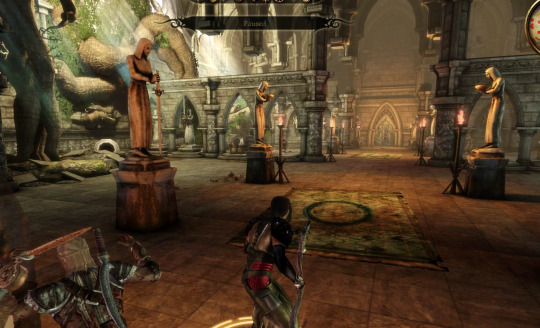
The chamber with the fire traps displays “Sylaise” and “Andruil” statues. Which in terms of Dalish Elven lore makes little sense. Andruil? Sure, she is the hunter goddess, though in these statues she is not in a aggressive stance. So is she chasing after you?. And what about Sylaise? The goddess of the domestic arts? Trying to kill you? Protecting the home of the elves? In a Tevinter structure? This makes a bit of more sense if we keep in mind what we know about Andruil from DAI and the little bit of Sylaise [read their sections in Evanuris]; Sylaise is a very agressive, envious goddes of Fire, who is described top have fire breath [like a dragon?], as powerful as Andruil’s spear [a very dangerous and brutal weapon so far we know]. Andruil is presented to us in DAI as the goddess of Sacrifice, brutal and merciless so far we can gather from the codices. So both goddesses seem to fit a bit better in a deadly trap room if we keep in mind the interpretation we had from DAI.
The Well of Sorrows: DAO version
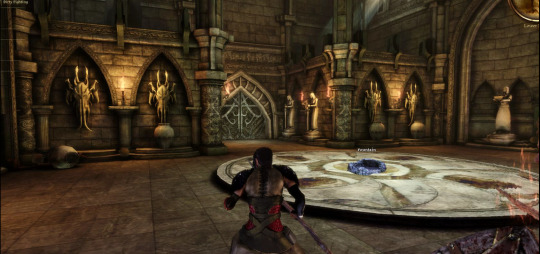
Then we reach to our first "Well of Sorrows". Or more like "Puddle of Sorrows", lol. Once again, we find a wall covered with that Dragon-like skull statues of “Andruil” and “Sylaise” [I keep the quotation mark because we know we can’t trust little these representations]. We also find the codex of an ancient elven tablet explaining the ritual which, after DAI, makes more sense. You drink from the water of the pool, taking the knowledge left by other elves, and then you put the rest of the water in it, leaving your knowledge there [it works similar to what Abelas explained about the Well of Sorrows]. It seems to be corrupted or empty since you don’t have any whispers or sudden knowledge inside your head, and many Shades are summoned if you fail in the procedure. This chamber unlocks the following one where we find the Uthenera chamber.

Since the only Elven god codex we found in these ruins is Falon'Din’s, it could be fair to believe that this may be interpreted like a "Well of Falon'din" which gathers all the knowledge of those elves that want to stop living and go to Uthenera.
This is consistent with the info provided in The Masked Empire, when Felassan explains that powerful mages went into Uthenera in underground tombs beneath Orlais and their servants had to take care of their bodies until they rebelled to them and slit their throats. This part of the Ruins are deep down underground. It is also reasonable in its location: Mythal’s Temple is located in the Arbor Wilds, South of Orlais, while this potential ruin in the depth of the Brecilian Forest. What’s a bit inconsistent is that some chars [Morrigan] said that this place was a Tevinter building [not an elvhenan one], but we can’t take Morrigan’s words as reliable either. She has been wrong many times along the series.

The one thing that deeply disturbed me was that there were two spirits, a little boy and a woman, clearly humans, talking in elven. We could assume they were elf-blooded, but there is no assurance in this. I want to believe this is not a mistake, there is purpose in them being humans since this game has elven models. There is no “engine” limitations there. Now, about the meaning of it, it’s another thing entirely.
The ghost human woman is beside the altar where you find the codex of Uthenera, some elven remains, and a piece of the Juggernaut (a lot of these Ruins History can be scratched via the rare items you find, so sometimes finding a particular item in a particular place is not minor).
Another detail that annoyed me is that the platform where the elven burial lays is surrounded by Alamarri/Tevinter statues. It’s not clear the story of this building: was it originally elvhen? retaken by Tevinter and later taken by elves again? Or this was an Elvhenan ruin, taken by the Avvar or Alamarri of any tribe, and then taken by Tevinter when they invaded the South? It’s not clear neither the original construction of this building nor the succesive invations and appropiations of it,
So the elven chamber dedicated to Uthenera is surrounded by dragon skull-like figures, there are Sylaise and Andruil statues on the outside ring and Alamarri/Tevinter statues with spears in the inner ring. Clearly this shows that we can’t truly trust much the enviromental telling of DAO due to the restriction of resources.
The Tevinter Artefacts
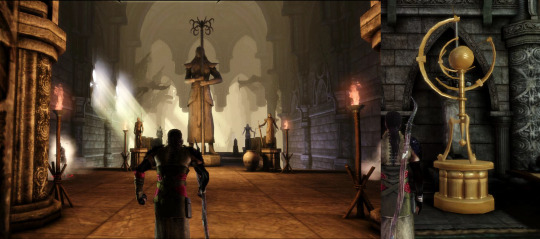
Finally, when you head to the deepest bottom of the ruins, you find a big statue I can't establish to what culture belongs yet; I speculate it's Tevinter due to the places where I found it most of the time. It has a similar flavor to the ones found in Kirkwall.
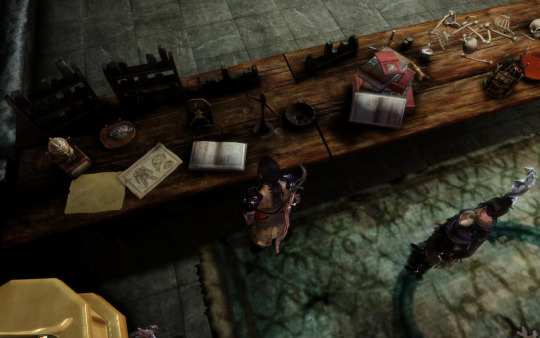
Behind it, an instrument with two tables filled with research stuff. The instrument is something that I can't decide if it is the same artefact we use in DAI to strengthen the Veil, those elven artefacts, or it's a prototype version of the Tevinter artefact to see the stars: the astrarium [which would make NO sense in the deep bottom of the Ruins, lol. What stars are you looking at?].

In any case, after this part you find a big chamber with a quincunx. Probably the first time we see this organisation. Which makes us remember Solas Tarot Card: the thing we find in a quincunx’s centre tends to be of great importance.

So, this disposition makes a quincunx inside another one, since each of them is also a quincunx, but its centre must be.... a person? a sacrifice?

And if this symbol were not crazy enough already, the squares have a Chantry symbol in each corner. Not the Imperial Chantry (which won’t be a big fuss) but the Standard Chantry! I can’t believe this is a lack of resources... the sunburst symbol is extremelly important in DA series.
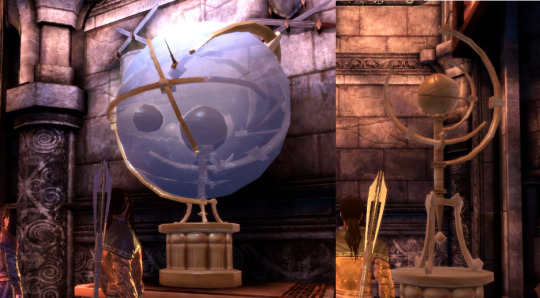

In the centre of this big chamber, once again, we found another artefact that may be an Astrarium or an Elven Artefact. We are sure it's Tevinter, since the same object can be found in the basement of the Circle of Magi. We have no idea what it does, or if it's related to any other artefact we found in DAI. (But it’s related to the one found close to the tables full of research stuff. They look the same, one only has a spherical glass around it while the other is more like the skeleton of the first one, with some missing part)

Anyway, returning to the quincunx Chamber: Here we fight an Arcane Horror. I always found these creatures with a design preeeetty close to the Sidereal Magisters. I don’t know if this means something, but in this context, it hints that a Tevinter experiment went wrong in this chamber and corrupted the mage performing it. It’s not by chance that Arcane Horrors are a product of a Pride demon taking control of a mage corpse. It has a big symbolism.
So, we can speculate that some Tevinter experiment happened here, there is no doubt. Not by chance Zathrian and the Oak tree tell us that the Brecilian Forest has a particular thin Veil, and rage demons possess the trees around. We also find a lot of revenants here (pride or desire demons bound by blood magic, explained in the codex The Black Vials). In short, Brecilian forest has similar symptoms to Kirkwall. Tevinter made experiments here, but it’s not sure if they were performed before or after the slave elves lived here.
Extra minor details
In these ruins is where we found a soul trapped (or bound?) to a gem that will teach us the ancient arts of the Arcane Warrior. It says that it is the last of their kind, implying that if you don’t acquire this knowledge, it will be lost forever and would make no sense for Viviene to have this knowledge in DAI.

All over the Ruins there are some rugs with a symbol that can be interpreted as an oversimplification of the Tevinter Imperium heraldry.
[Index page of Dragon Age Lore ]
#Playing DA like an archaeologist#quincunx#tevinter#dragon#andruil#sylaise#tevinter artefacts#uthenera#brecilian ruins#elven pantheon
32 notes
·
View notes
Text
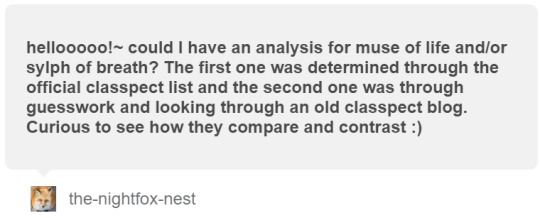
The Sylph of Breath [symbols: fairy wand, wind]
The Sylph class has its basis in the nymphs of Greek mythology. An example would be the Fairy Godmother trope.
The Breath aspect’s main theme is freedom. You can find its official description here.
A Sylph of Breath is among those who alter paths, drive, and passion. This is the “classpect group” they belong to. Members include: the Sylph, Maid, Bard, and Prince of Breath/Blood. These classes are all opposites or inverses of each other that alter the Breath/Blood dichotomy (paths, drive, and passion). A description of classpect groupings can be found here.
The Sylph of Breath passively assists the Breath aspect. Passive classes are guided by others or act for the benefit of others. They are more likely to be kind, but less likely to stand up for themselves. Sylphs and Maids aid their aspect and everything it symbolizes or use it as a form of aid. Simplified, the Sylph of Breath is motivated by others to assist freedom.
In personality, the Sylph of Breath feels useless when they can't help others and dislikes commitment. Personality descriptions can be found here.
Their archetype is the Mother Escapee, defined by helping freedom. Archetypes are explained here.
Their opposite is the Maid of Blood, who actively assists connection.
Their inverse is the Prince of Blood, who actively destroys connection.
A classpect or “god tier” is an individual’s best self. All classpects go through a journey from unrealized, to struggle, to realized. When a character is unrealized, they neutrally exist as their inverse. On their struggle, they will wildly flip back and forth between their inverse and true classpect. In their worst moments they will act as their inverse, in their best their true classpect. When realized, they will stabilize as their true classpect. They will still have room to grow, but will become happier, more successful people.
This means that the Sylph of Breath begins life motivated by themselves to destroy connection. When their struggle arrives and they are at their worst, they will continue this behavior in negative extremes. However, when at their best, they will find purpose in instead assisting freedom for others. When realized, they will stabilize and continue to assist the Breath aspect passively, in a positive way.
They share their archetype with the Maid of Space, the Escapee Mother.
The Sylph of Breath would quest on a planet similar to the Land of Shine [Sylph] and Breath [Aspect]. An example would be the Land of Glimmer and Flurries. An explanation of planet naming conventions can be found here.
Two possible gods, or denizens, to reign over their planet would be Zeus (God of Thunder) or Hermes (the Messenger God). Other Breath aspect denizens can be found here.
When the Sylph of Breath completes their planet quests and dies on their quest bed, they would rise to ascension on the wings of fireflies (symbols of the fae). A list of soul animals can be found here.
The characters that I have currently classpected as Sylphs of Breath are: Florence + the Machine from Ke$hastuck and Sylaise from Dragon Age.
If any of the links not connected to my blog break, the content can be found on my Google Drive.
Official Aspect Descriptions
Personality Descriptions
Aspect Denizens
Muse of Life analysis can be found here.
#sylph of breath#homestuck#god tier analysis#classpecting#my post#ask#florence + the machine#sylaise#ke$hastuck#dragon age
6 notes
·
View notes
Text
"my people had a saying long ago. the healer has the bloodiest hands."
I'm SURE someone has talked about this solas quote in connection with sylaise, who is associated with healing in dalish lore. what was girlypop up to?? what did she do?? I need to know. This codex entry found in the temple of mythal:
Sylaise, whose heat rivals Elgar'nan's light.
Sylaise, whose temples rival Mythal's cities.
Sylaise, whose breath rivals Andruil's spear.
Sylaise, whose skill rivals June's craft.
Sylaise, whose fire cannot be quenched.
It's interesting because this suggests a rivalry between sylaise and the other gods. she's arguably portrayed as the softest or most benevolent in dalish lore. perhaps she felt inadequate compared to the rest of the evanuris and sought to distinguish herself among them.
My somewhat out there theory here is that "breath" being compared to a weapon and the references to "heat and fire", combined with the idea of healing perhaps suggest a plague or a disease (heat being a fever.) perhaps she created some sort of "bioweapon" and withheld healing until people payed attention to her and showed her the devotion she felt she was owed. "the song of sylaise" reads as very egotistical and insecure if we take it to be a reflection of sylaise's personality/objectives as a ruler. Her path, the Vir Atish'an, means "the way of peace". a bioweapon would be a form of warfare perhaps seen as "peaceful" compared to outright violence favoured by the other gods.
Through the lens of the sphere can be seen a world of indigo waterfalls and rust-red jungles
this is part of the description of the sonallium (gifted to june by sylaise) in a codex entry found in the vir dirthara. perhaps a massive reach but this place doesn't sound like anywhere we know yet in thedas (perhaps seheron) and so maaaaybe it was an illness found somewhere exotic that the elves had no native defences against?? This is pure baseless speculation, the quote might not have anything to do with her lol. I just desperately need to know more about Sylaise.
#dragon age theories#dragon age lore#sylaise#the evanuris#evanuris#i need evanuris info now!!!!#dragon age#da meta#dragon age talks
3 notes
·
View notes
Text
Linking the Old God Symbols/Crowns and the Evanuris tldr:
Evanuris and Old Gods linked in my previous post.
Ghilan'nain and Dirthamen Symbols were taken from the mural with the two Evanuris.
Elgar'nan is the Sun.
Sylaise is linked to Urthemiel and the same crown appears in an elven mural with the figure looking feminine.
Andruil's symbol resembles a Hawke and also is liked to the other feminine figure in the murals with a bow structure above the head.
Falon'Din's is based on his vallaslin.
June is the most angular, just like his mural.

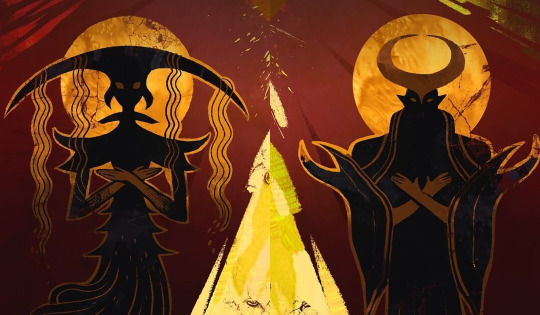


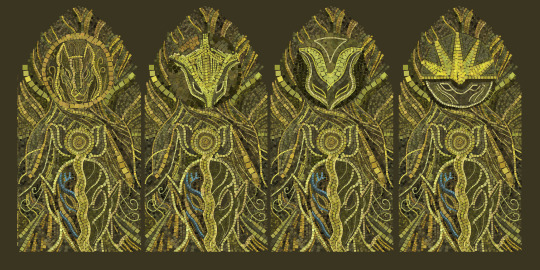

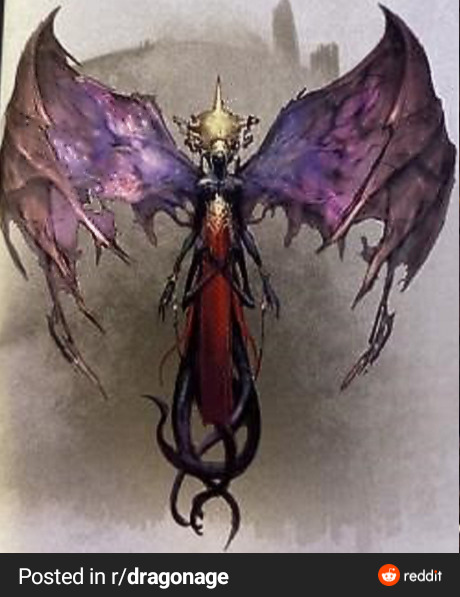
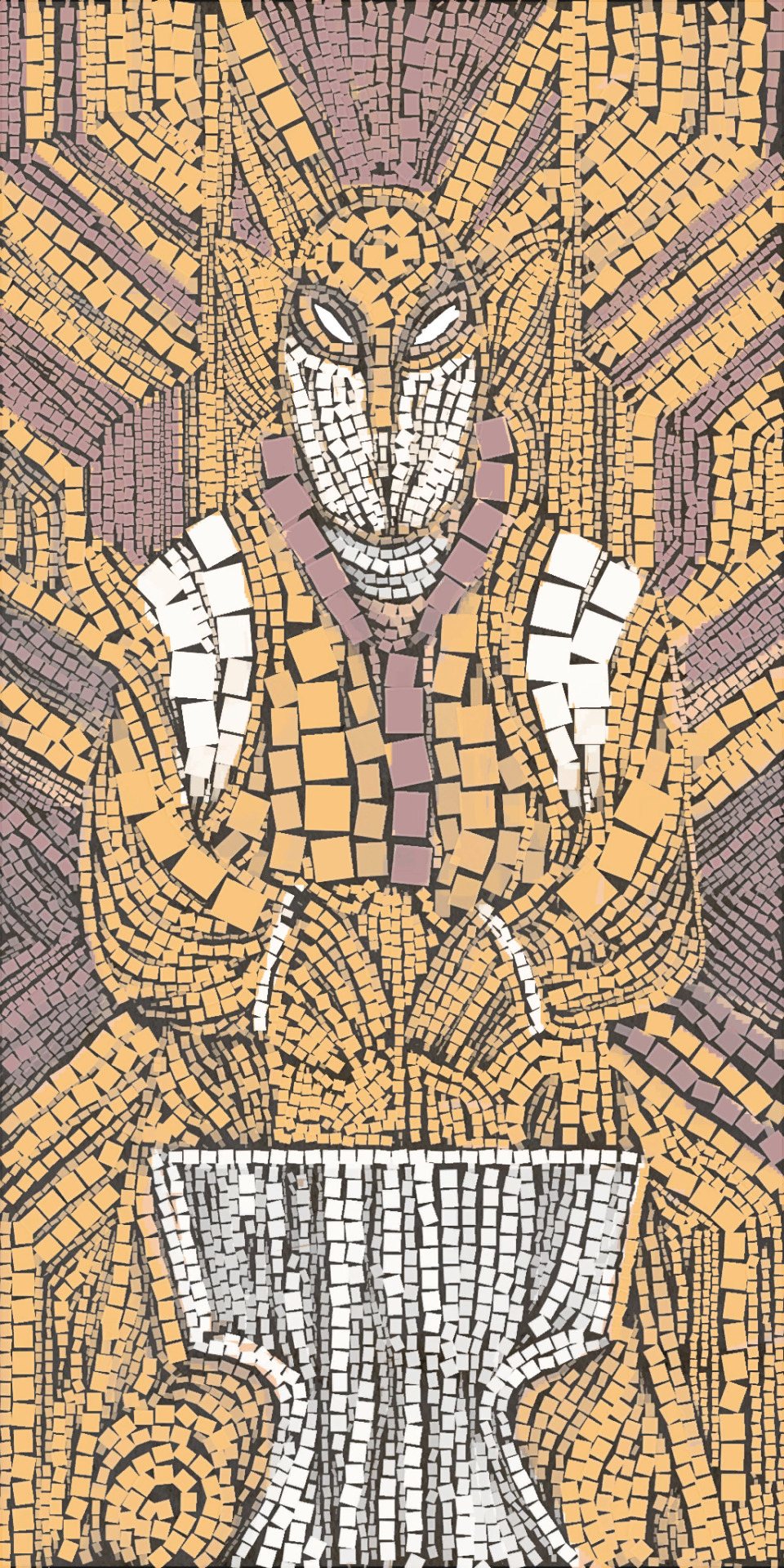
17 notes
·
View notes
Link
In the Fade, Solas tells Ixchel a parable of Sylaise that is all too real.
24 notes
·
View notes
Text
I've been thinking about how Ghilan'nain could be seen as a sort of Aphrodite figure among the Dalish. This is not a 1 to 1 comparison, one of the things I really like about the elven pantheon is that they are a fairly self contained set of fantasy deities. Meaning that rather than just being irl gods with new skins they seem more like someone looked at what kinds of gods usually appear among polytheistic cultures and made their own to suit Thedas.
But anyway, Ghilan'nain, Aphrodite. I started comparing them because they are both outsiders among their peers. Ghilan'nain was a mortal raised up to deity by Andruil, among gods who are very nepotistically otherwise related by blood. All the other Evanuris are Mythal and Elgar'nan's children far as I know. Except perhaps June, which is a point of debate since he is depicted as both Sylaise's husband and brother. It might be one of those things that vary depending on the source, and honestly he might have very well been both.
So anyway this has lead me to headcanon that Ghilan'nain is also considered a goddess of beauty. She'd represent the unmarried maiden in a sense. She and Andruil together could be seen as two sides of sexuality. Andruil being the lust and the one who pursues it and Ghilan'nain the one who invokes lust.
I say this because you also have Sylaise and June representing the young married couples, and Mythal and Elgar'nan the mother and father and an older union. So it's like you've got three types of relationships all with their flaws and benefits represented. Ghilan'nain and Andruil definitely represent lust and passion and romance and all its wildness, Sylaise and June might represent a happy but untested marriage, and Mythal and Elgar'nan are here to be our messy old couple who are staying together for the kids and also because it's either that or one of them killing the other, probably.
Similarly to the Greeks, the Dalish pantheon retain their personable qualities and are seen as people, as opposed to perfect omniscient beings, which makes them very interesting and good for the kind of fables with drama and theatrics with some lesson about human nature at the core.
#jasko writes#dragon age#dragon age inquisition#dai#evanuris#ghilan'nain#andruil#mythal#elgar'nan#sylaise#june#dalish#dragon age headcanon
18 notes
·
View notes
Photo
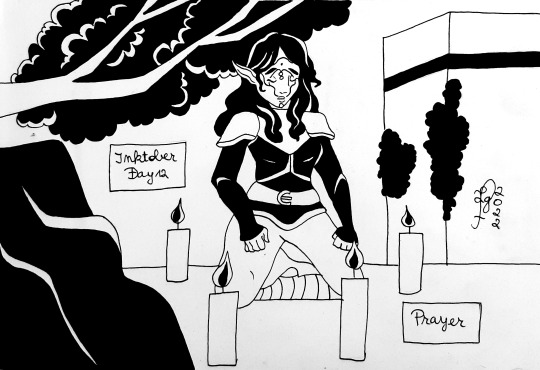
Inktober, Day 12 : “Prayer” (prompts list) - A prayer to Sylaise
#dragon age#sylaise#inktober#inktober 2022#inktober 2022 day 12#flo posts#flo draws#dalish#dalish elves
6 notes
·
View notes
Text

Just Shivana (I think I’m in love with her)
#my art#can’t force myself to put color on anything lately rip#shivana lavellan#dragon age inquisition#dragon age#dai#lavellan#dragon age fanart#the sylaise vallaslin is so#fucking hard to draw#I love it but why#why do I do these things to myself#I remember when I gave her this one and I was like#the full sylaise vallaslin is so cool but I don’t see it so often so I’ll give her this one#I was so innocent then#I know why now
674 notes
·
View notes
Text
ok. daichi dragon age au. seeker of truth — trained healer but still first and foremost a seeker, more templar-adjacent, heavy on the shield imagery and the stubbornness of justice, staunchly andrastian but operating outside the bounds of the chantry
OR. daichi from a super remote mountain dalish clan that his dad took refuge with when daichi was a wee baby for mumblemumble reasons; trained healer and the keeper's first (keeper helaine?); half-human so a little awkward and ungainly compared to the rest of the dalish kids but stubbornly making up for his deficits
#I just can't decide if I want him to be a mage or not. on the one hand yeah he should be!#he could be a follower of Mythal or Sylaise and really devout. then he has to leave the clan for some reason and he can pass as human#but it's such a strange thing being out in a world so different from the one he knows and have to recalibrate everything#but ALSO SoT daichi so steady in his faith that he calls a spirit of faith to him and that being a guiding part of him as a person—#not necessarily faith in the maker or andraste but just the undiluted belief in doing what is right and just#plus the shield imagery. tho I guess dalish!dai could have a shield. and who's to say the seekers can't have magical healing if they want#also it makes his dad's story way different if he's andrastian or dalish soooo. yeah. anyway.#I'm permitting myself one (1) procrastination ocposting before I go back to work#daichi#.dragon age au
5 notes
·
View notes
Text
studying which vallaslin to give my dalish ocs like it’s the most important decision i’ll ever make. battle between ‘which is best stylistically’ and ‘which is best symbolically’ and ‘which is going to make me want to incinerate myself the least when i try to draw it’
55 notes
·
View notes
Text
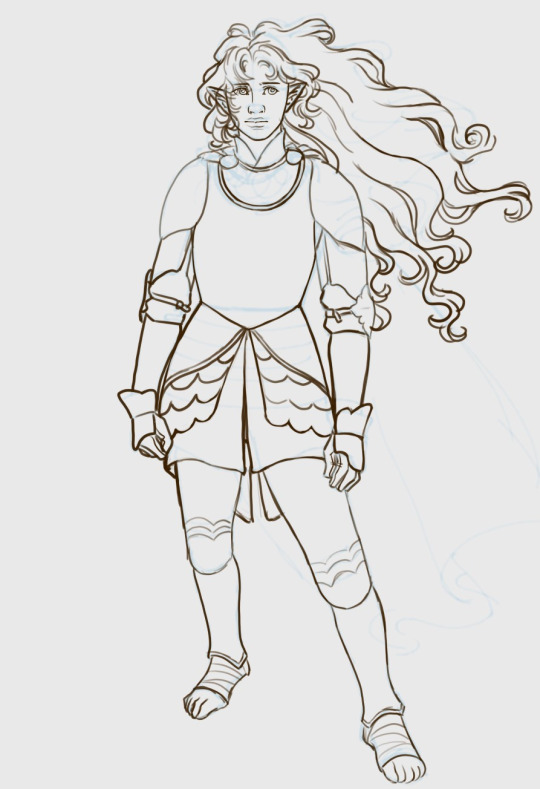
WIP of an armor design from the Sylaise’s Daughter AU because it’s Missing Her hours.
11 notes
·
View notes
Text


meet [unnamed inquisitor oc] :33333 he, and i quote, "looks like his first name is gay sex & his last name with an apostate mage". & technically dorian is an apostate so not far off
#dragonageposting#oc tag#id in alt#isnt he so gooddddd its the first time i have an inquisitor that actually looks good aside from my one cadash 💀..#my tv screen is just so weird i always end up not processing whats on the screen right#& then i see the character in action & im like oh. oh no.#but this time! i was playing on pc. so it was a lot easier to know what i was doing pretty much#& yeah it was my first time trying to make an elven inquisitor actually look similar to how elves look in 2...#i should make shamir in inquisition <- would be forever unsatisfied with the extremely limited customisation#on that note shamir is meant to have sylaise's vallaslin i just uh. well i was very bad at drawing it it seems#this isnt about shamir though. my inq!!!!!!!! one of. my inqs. !!!
2 notes
·
View notes